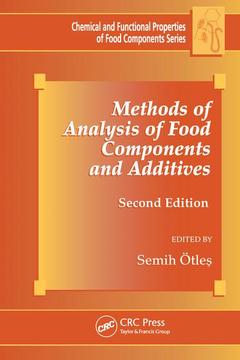Description
Methods of Analysis of Food Components and Additives (2nd Ed.)
Chemical & Functional Properties of Food Components Series
Coordinator: Otles Semih
Language: English
Subjects for Methods of Analysis of Food Components and Additives:
Keywords
Sample Preparation; Target DNA; solid; Atomic Absorption Spectrometry; phase; Benzoic Acid; extraction; ELSD; thin; PLE; layer; Thermal Lens Spectrometry; chromatography; PCB Congener; gas; Cry9C Protein; capillary; Data Set; electrophoresis; Food Allergens; high-performance; Electrothermal Atomization Atomic Absorption Spectrometry; Sorbic Acid; Pesticide Residue Analysis; Se Species; Polyclonal Ab; Inductively Couple Plasma Mass Spectrometry; Dimethyl Benzyl Ammonium Chloride; Amino Acid; AOCS Method; Wet Digestion; Mass Transfer; Standard Plate Agar; Dehydroacetic Acid; Olfactory Epithelium
Publication date: 10-2016
· 15.6x23.4 cm · Paperback
Publication date: 12-2011
519 p. · 15.6x23.4 cm · Hardback
Description
/li>Contents
/li>Readership
/li>Biography
/li>
With diet, health, and food safety news making headlines on a regular basis, the ability to separate, identify, and analyze the nutrients, additives, and toxicological compounds found in food and food components is more important than ever. This requires proper training in the application of best methods, as well as efforts to improve existing methods to meet analytical needs. Advances in instrumentation and applied instrumental analysis methods have allowed scientists concerned with food and beverage quality, labeling, compliance, and safety to meet these ever-increasing analytical demands. This updated edition of Methods of Analysis of Food Components and Additives covers recent advances as well as established methods in a concise guide, presenting detailed explanations of techniques for analysis of food components and additives.
Written by leading scientists, many of whom personally developed or refined the techniques, this reference focuses primarily on methods of food analysis and novel analysis instruments. It provides readers with a survey of modern analytical instruments and methods for the analysis of food components, additives, and contaminants. Each chapter summarizes key findings on novel analysis methods, including the identification, speciation, and determination of components in raw materials and food products. The text describes the component or additive that can be analyzed, explains how it works, and then offers examples of applications.
This reference covers selection of techniques, statistical assessments, analysis of drinking water, and rapid microbiological techniques. It also describes the application of chemical, physical, microbiological, sensorial, and instrumental novel analysis to food components and additives, including proteins, peptides, lipids, vitamins, carotenoids, chlorophylls, and food allergens, as well as genetically modified components, pesticide residues, pollutants, chemical preservatives, and radioactive components in foods. The Second Edition contains three valuable new chapters on analytical quality assurance, the analysis of carbohydrates, and natural toxins in foods, along with updates in the remaining chapters, numerous examples, and many new figures.
Selection of Techniques Used in Food Analysis. Statistical Assessment of Results of Food Analysis. Analytical Quality Assurance. Analysis of Drinking Water. Analysis of Proteins, Peptides, and Amino Acids in Foods. Extraction and Analysis of Food Lipids. Analysis of Carbohydrates in Foods. Determination and Speciation of Metals and Trace Elements in Foods. Analysis of Vitamins for the Health, Pharmaceutical, and Food Sciences. Analysis of Carotenoids and Chlorophylls in Foods. Analysis of Polyphenols in Foods. Sensory Analysis of Foods. Determination of Food Allergens and Genetically Modified Components. Determination of Pesticide Residues. Determination of Pollutants in Foods. Analysis of Chemical Preservatives in Foods. Measuring Radioactive Contaminants in Foods. Rapid Analysis Techniques in Food Microbiology. Analysis of Natural Toxins in Foods.
Semih Otles is Vice Dean of the Engineering Faculty at Ege University in Turkey.




